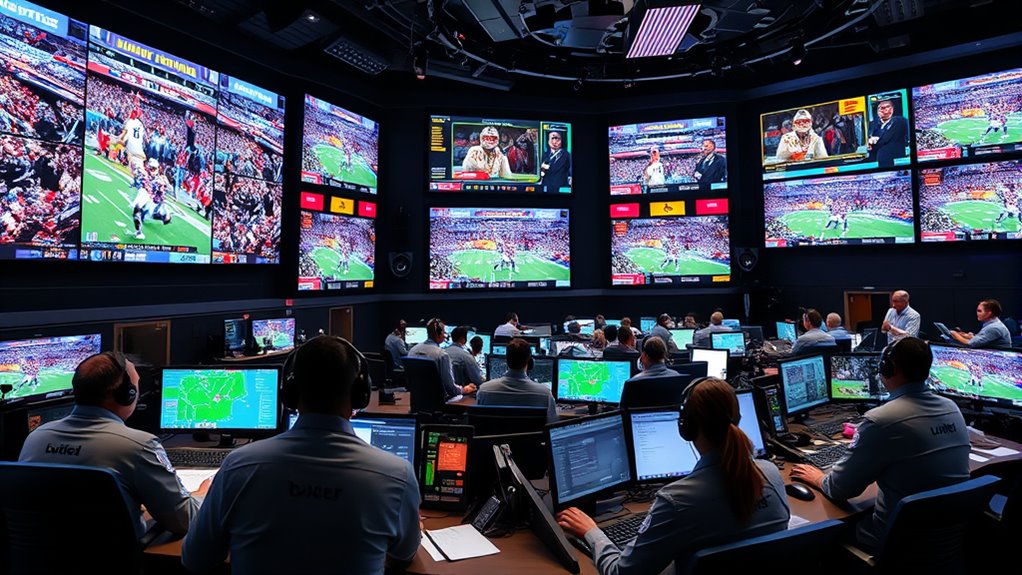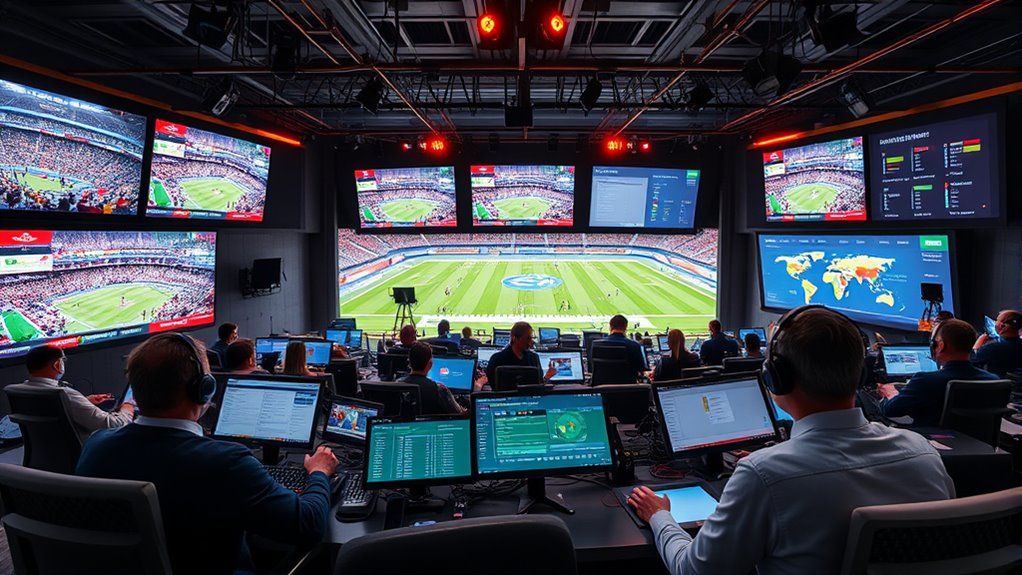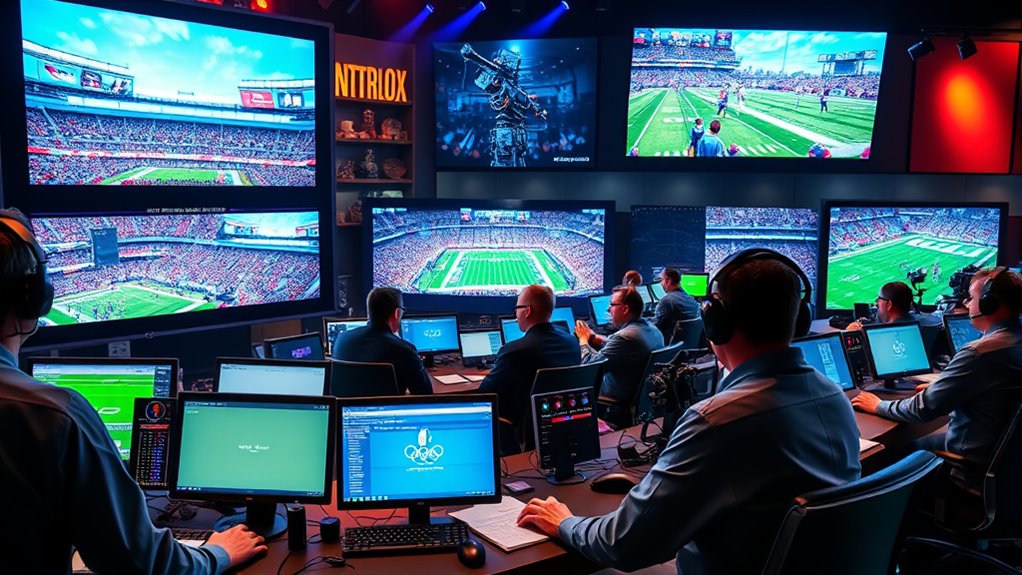Broadcasters and streamers team up during major events like the Super Bowl or Olympics to deliver synchronized, high-quality coverage. They use official allowlists to control who can stream, ensuring content stays within brand guidelines. Advanced infrastructure helps keep streams aligned, while real-time analytics measure viewer engagement and reach. Strategic cooperation boosts audience size and engagement across platforms. Want to see how these collaborations overcome challenges? Keep exploring for more insights.
Key Takeaways
- Broadcasters provide approved allowlists and content guidelines to streamers, ensuring consistent and brand-safe coverage.
- Technical infrastructure, including synchronized streaming systems and real-time data sharing, facilitates seamless co-broadcasts.
- Aggregated viewership analytics track audience engagement across all co-streams, enabling strategic adjustments.
- Coordinated community engagement activities, like live chats and themed events, enhance viewer participation.
- Regular communication and strict permissions manage content quality, safety, and uphold event integrity during collaboration.
The Role of Main Broadcasters and Allowlists in Co-Streaming

Main broadcasters play a crucial role in guaranteeing that co-streaming arrangements are both effective and aligned with brand standards. They do this by providing allowlists—curated lists of approved streamers authorized to broadcast the event. These allowlists give you control over who can co-stream, helping to protect the event’s integrity and maintain quality. When you’re part of this system, the broadcaster’s permissions ensure your stream complies with content guidelines and brand safety protocols. This centralized approval process reduces risks of unauthorized rebroadcasts or content misuse. It also streamlines cooperation, making it easier for you to deliver your unique commentary while staying within the event’s official parameters. Overall, allowlists serve as a crucial tool for balancing creative freedom with brand protection during large-scale live broadcasts. Additionally, understanding the importance of relationships in content sharing helps broadcasters foster trust and collaboration with streamers.
Technical Infrastructure and Synchronization for Simultaneous Broadcasts

Ensuring smooth simultaneous broadcasts during co-streaming requires a robust technical infrastructure that can handle high volumes of data with minimal latency. You need reliable streaming servers, optimized content delivery networks (CDNs), and low-latency encoding systems to synchronize streams accurately across platforms. These systems work together to minimize delays, ensuring viewers experience a seamless, synchronized event regardless of their streaming location. Precise time-stamping and real-time data transmission are critical for aligning audio and video feeds from multiple sources. You also rely on adaptive bitrate streaming to accommodate varying internet speeds, preventing buffering issues. Constant monitoring and quick troubleshooting are essential to maintain synchronization during live coverage, minimizing disruptions and preserving the authenticity of the shared event experience. Additionally, understanding streaming technology is vital for optimizing broadcast quality and ensuring a consistent viewer experience.
Analytics and Data Sharing: Measuring Reach and Engagement

Accurate measurement of reach and engagement is the backbone of successful broadcaster and streamer collaborations during live events. You rely on platforms that aggregate viewership data from all streams, giving you a clear picture of total audience size. Analytical dashboards help you monitor each co-streamer’s contribution, revealing which moments drive peak engagement. Real-time metrics like Average Concurrent Viewership (ACV) and Peak CCV show audience stability and high-interest points, guiding strategic decisions. You can also access individual streamer analytics to benchmark performance and optimize partnerships. Data sharing enhances transparency and accountability, ensuring everyone understands the event’s impact. This integrated approach counters fragmented viewership, allowing you to measure true reach and engagement across multiple channels accurately. It’s essential for evaluating success and planning future collaborations. Additionally, understanding projector technology can help broadcasters improve visual presentation quality for streamed content, enhancing viewer experience and engagement.
Strategic Advantages of Collaborative Streaming for Large-Scale Events

Collaborative streaming offers significant strategic advantages for large-scale events by amplifying reach and engagement. By partnering with multiple streamers, you can tap into diverse audiences across different communities, increasing overall viewership. This approach assures your event is accessible on various platforms, breaking down barriers for fans worldwide. It also fosters community involvement, as viewers feel more connected through personalized commentary and interactive content. Additionally, co-streaming helps you gather real-time insights into audience preferences and behaviors, enabling quick adjustments for future coverage. The collective effort creates a unified, dynamic broadcast that maximizes exposure while maintaining control over content quality. Incorporating streaming technology can further enhance the seamlessness and quality of collaborative broadcasts. Ultimately, this strategy strengthens your event’s visibility and impact, driving higher engagement and broader recognition across multiple viewer segments.
Managing Content Quality and Brand Safety in Co-Streaming Arrangements

Managing content quality and brand safety in co-streaming arrangements requires proactive oversight and clear guidelines. You need to establish strict allowlists, ensuring only vetted streamers can broadcast the event, which helps maintain control over the content and protect brand reputation. Regular communication with streamers sets expectations around commentary, visuals, and engagement standards. Implement platform safety features and moderation tools to prevent inappropriate content or misuse. Use analytical dashboards to monitor streams in real-time, catching issues early. Enforce compliance with legal and contractual obligations through automated alerts and manual reviews. By maintaining oversight from setup through live broadcasting, you guarantee consistent quality, avoid brand damage, and foster trustworthy collaborations that benefit all parties involved. Additionally, understanding electric bike speed capabilities can help tailor safety protocols and content guidelines for faster or more powerful streams.
Audience Engagement and Community Building Through Multi-Channel Coverage

By leveraging multi-channel coverage, you can amplify community interaction and create shared experiences that resonate with diverse audiences. As broadcasters and streamers collaborate, they foster a sense of belonging and excitement around live events. This approach not only boosts engagement but also strengthens the connection between viewers and the content. Incorporating audience engagement strategies can further enhance the effectiveness of these collaborative efforts.
Amplifying Community Interaction
Multi-channel coverage markedly boosts community interaction by allowing you to engage with content across various platforms and streamers simultaneously. You can join live chats, share clips, and comment in real time, creating a sense of shared excitement. Streamers often encourage viewer participation through polls, Q&A sessions, or interactive overlays, making you feel part of the event. With multiple streams, you can explore different perspectives, commentary styles, or localized content, deepening your connection to the event. Platforms like Twitch enable seamless interaction with chat features and social media integration, amplifying your voice. This multi-channel approach fosters a vibrant community where viewers feel more involved, driving engagement and building a collective experience that enhances the overall viewing pleasure. Additionally, integrating mechanical elements and Victorian-inspired aesthetics into the broadcast environment can evoke a steampunk ambiance, enriching the visual experience and fostering a unique sense of community among fans.
Fostering Shared Experiences
When multiple streams cover the same event, viewers find new ways to connect and share their experiences. You can participate in real-time conversations, compare commentaries, and celebrate shared moments across platforms. To foster this sense of community, consider these strategies:
- Encourage interactive features like live chat and polls within streams.
- Coordinate themed viewing parties across channels for unified engagement.
- Promote hashtag campaigns that unify social media discussions.
- Highlight viewer contributions and reactions during broadcasts to boost participation.
- Leveraging multichannel content distribution ensures broader reach and deeper audience involvement.
Overcoming Challenges: Fragmentation, Compliance, and Technical Hurdles

Fragmentation of viewership has long posed a challenge for broadcasters and streamers aiming to measure the true impact of their joint events. When audiences watch across multiple streams and platforms, tracking total engagement becomes complex. To overcome this, you need robust analytics that consolidate viewership data from all co-streams, providing a clear picture of total reach. Ensuring content quality and brand safety also requires strict controls, like curated allowlists and platform guidelines, to prevent misuse or inconsistent messaging. Technical hurdles, such as synchronizing streams and managing latency, demand reliable infrastructure and real-time monitoring. Additionally, implementing vertical storage solutions can help organize vast amounts of content efficiently, making it easier to access and analyze viewer data. By addressing these challenges with effective tools and clear communication, you can optimize cooperation, accurately measure success, and deliver a seamless viewing experience for your audience.
The Impact of Industry Trends and Market Growth on Broadcaster-Streamer Partnerships

Industry trends like the rise of virtual events and expanding live sports markets create new opportunities for broadcasters and streamers to collaborate more effectively. Technological innovations, such as advanced analytics and real-time synchronization, make these partnerships more seamless and impactful. As the market continues to grow, you’ll find that embracing these shifts can remarkably boost reach, engagement, and revenue for both parties. Additionally, employing reliable backup power solutions ensures uninterrupted broadcasts during critical moments, maintaining viewer trust and operational continuity.
Emerging Market Opportunities
The rapid growth of live streaming markets and technological advancements are opening new opportunities for broadcasters and streamers to collaborate more effectively. As the industry expands, you can leverage these trends to access emerging market opportunities:
- Expanding Geographic Reach: New platforms enable access to previously untapped audiences in emerging regions, increasing event visibility.
- Diversifying Content Offerings: Collaboration allows for localized commentary and interactive experiences tailored to niche markets, boosting engagement.
- Monetization Innovations: Growing audiences support new revenue streams like targeted advertising, sponsorships, and premium co-stream content.
- Strategic Partnerships: Industry growth encourages alliances among broadcasters, streamers, and brands, fostering innovative content formats and shared audiences.
These opportunities empower you to capitalize on increasing demand, diversify your offerings, and deepen audience engagement in emerging markets.
Technological Innovation Drivers
Advancements in streaming technology and shifting consumer preferences are accelerating the integration of broadcasters and streamers, making their partnerships more dynamic and impactful. New tools and platform features enable seamless collaboration, real-time analytics, and synchronized content delivery. Industry trends like the growth of live sports streaming and virtual events push broadcasters and streamers to innovate, maximize reach, and enhance viewer engagement. These innovations foster tailored content, broader audience access, and improved measurement of impact.
| Innovation Type | Impact | Example |
|---|---|---|
| Co-streaming Features | Facilitate simultaneous coverage | Twitch allowing approved co-streams |
| Real-time Analytics | Track audience engagement | Peak Viewership metrics |
| Platform Integrations | Enable seamless collaboration | Unified dashboards for broadcasters and streamers |
| Content Safety Tools | Ensure brand safety | Allowlists and moderation tools |
Leveraging Influencers and Local Content to Broaden Audience Reach

Leveraging influencers and local content has become a powerful strategy to expand audience reach during major events. You can do this by:
- Partnering with local influencers who have engaged communities, making the event more relatable and accessible.
- Encouraging streamers to create region-specific content that highlights local traditions, fan reactions, or regional stories.
- Incorporating influencer commentary to add authenticity and personalized insights, attracting diverse viewer segments.
- Using localized hashtags and interactive features to boost visibility and engagement within specific communities.
This approach helps bridge the gap between global event coverage and local interests, creating a more inclusive experience. By integrating regional voices and content, you can effectively broaden your audience, increase engagement, and foster community loyalty during high-profile events.
Future Outlook: Innovations and Evolving Cooperation Models in Live Event Coverage

As live event coverage continues to evolve, innovative cooperation models are emerging to enhance collaboration between broadcasters and streamers. You’ll see more integrated platforms offering seamless co-streaming capabilities, making it easier to coordinate real-time content sharing. Advanced AI and machine learning will provide deeper audience insights, allowing broadcasters and streamers to tailor content dynamically and optimize engagement. Future models will emphasize flexible licensing, enabling streamers to create personalized commentary while adhering to brand standards. Virtual reality and augmented reality technologies will add immersive experiences, inviting viewers to engage more interactively. Additionally, new revenue-sharing structures and hybrid models will incentivize broader participation, creating a more unified, efficient ecosystem for live event coverage. These innovations will reshape how audiences experience events, blending scale with personalization.
Frequently Asked Questions
How Do Platforms Ensure Fair Revenue Sharing Among Co-Streamers?
Platforms guarantee fair revenue sharing among co-streamers by implementing transparent, data-driven systems that track viewership and engagement for each streamer involved. They set clear rules and agreements upfront, often including revenue split percentages based on contribution metrics. Automated tools distribute earnings proportionally, and detailed analytics help verify individual performance. This process fosters trust, encourages participation, and guarantees that each co-streamer receives an equitable share of the revenue generated during the event.
What Legal Considerations Exist for Copyright and Licensing in Co-Streaming?
Think of copyright and licensing like a tightrope you walk carefully. You must obtain permissions from rights holders, often through allowlists or licensing agreements, to legally co-stream content. Violating these rules risks legal action, fines, or content takedowns. Always verify you’re authorized, respect intellectual property rights, and follow platform guidelines. This careful balancing act safeguards your content, reputation, and the integrity of the event coverage you’re sharing.
How Is Viewer Data Privacy Maintained Across Multiple Co-Stream Channels?
You’re protected by platform policies that enforce data privacy standards across all co-stream channels. These platforms anonymize viewer data, preventing the sharing of personally identifiable information between streams. They also implement strict security measures, ensuring that viewer data remains confidential and compliant with privacy regulations like GDPR and CCPA. By using aggregated analytics, you get insights without compromising individual user privacy, maintaining trust while measuring audience engagement effectively.
What Technical Standards Are Used to Synchronize Streams Seamlessly?
Think of stream synchronization like a perfectly choreographed dance—timing is everything. To achieve this, you rely on standards like Real-Time Messaging Protocol (RTMP) and Secure Reliable Transport (SRT), which act as the beat, keeping every streamer in step. These protocols minimize latency, ensuring that every viewer experiences the event in harmony, as if everyone’s watching the same heartbeat pulse through their screens.
How Do Broadcasters Select and Vet Streamers for Allowlists?
You choose and vet streamers for allowlists by evaluating their content quality, audience demographics, and past streaming behavior. You review their channels to ensure they align with your brand standards and compliance guidelines. You may also conduct interviews or test streams to evaluate their professionalism and technical capabilities. By doing this, you ensure that only trustworthy, high-quality streamers are permitted to co-stream your event, maintaining brand safety and content consistency.
Conclusion
While some worry about brand safety or technical issues, embracing collaboration between broadcasters and streamers actually expands your reach and engagement. By working together, you can deliver seamless, high-quality coverage that appeals to diverse audiences. This partnership isn’t just a trend—it’s the future of live event coverage, opening new opportunities for growth. So, don’t fear the challenges; instead, see them as stepping stones to more innovative, inclusive broadcasting experiences.










